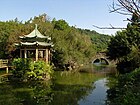 | |
| Ancestor | Arch bridge |
|---|---|
| Carries | Pedestrians |
| Material | Stone, brick, and wood |
A moon bridge (月桥), also known as “sori-bashi" (反り橋) in Japanese, or as a drum bridge (“taiko-bashi” 太鼓橋),[1] is a highly arched pedestrian bridge. The moon bridge originated in China and was later introduced to Japan, where it became synonymous with Japanese landscape architecture. However, the general shape of this bridge can be seen throughout East Asian cultures.[1][2][3][4]
Generally, these bridges are non-functional, serving as ornamentation.[5] However, they were originally designed to allow pedestrians to cross canals while allowing the passage of barges beneath. To achieve this height in normal bridge construction, significant space from the river banks must be used for the approaches of the bridge. The climbing ascent and descent of the moon bridge has the advantage of conserving this space. These approaches can be very steep on moon bridges, sometimes requiring ladder-like rungs to be affixed to the bridge.[6][5]
Moon bridges can be constructed from a variety of materials and construction techniques. Some wooden moon bridges employ a “woven-arch” style: cross beams are threaded between the longitudinal members, developing inherent stiffness and shape.[1] Though rare, this technique is displayed on the 12th century Chinese “Rainbow Bridge”, the 1913 moon bridge in the Japanese garden of the Huntington Library in California.
In formal garden design, a moon bridge is placed so that it is reflected in still water. The high arch and its reflection form a circle, symbolizing the Moon. By forming a reflected full circle, the bridge also symbolizes purity: the Chinese words for “full” and “circle” together translate to “perfection”.[1]
-
Shuangxi Park and Chinese Garden Taipei
-
Bridge reflecting in the lake in the evening (Dunedin Chinese Garden)
-
A full circle forms due to the shape and reflection of Engetsu-kyō stone bridge at Koishikawa-Kōrakuen in Tokyo, Japan
-
Moon bridge with a "woven-arch" construction
- ^ a b c d Liu, Yan (2020). "A full moon in another land: The Moon Bridge in the Japanese garden of the Huntington Library". Frontiers of Architectural Research. 9 (3): 556–567. doi:10.1016/j.foar.2020.02.004. ISSN 2095-2635.
- ^ Boults, Elizabeth; Sullivan, Chip (2010). Illustrated history of landscape design. Hoboken, NJ: J. Wiley. p. 118. ISBN 978-0-470-28933-4.
- ^ Ono, Kenkichi; Edwards, Walter. "full-moon bridge 偃月橋・円月橋". Japanese Garden Dictionary: A Glossary for Japanese Gardens and Their History. Retrieved 2 September 2011.
- ^ Bernal, Peggy Park (1999). The Huntington Library, Art Collections, and Botanical Gardens. San Marino, California: Huntington Library. p. 23. ISBN 9780873281348.
Moon bridges were a feature of Chinese garden architecture, adopted by the Japanese in the thirteenth century. The large, rounded bridge is usually known as a moon bridge because the arch and the reflection in the water below form a full form a full moon shape, and also because "moon viewing" from beneath the bridge was a diversion for estate owners cruising on their private lakes.
- ^ a b Barnett, Tara (2022-10-12). "What Is a Moon Bridge?". All the Science. Retrieved 2022-11-10.
- ^ Kozaburo, Tamamura. "Taiko-Bashi (Drum) Bridge at Kameido Shrine". Nagasaki University Library. Retrieved 2022-11-10.




